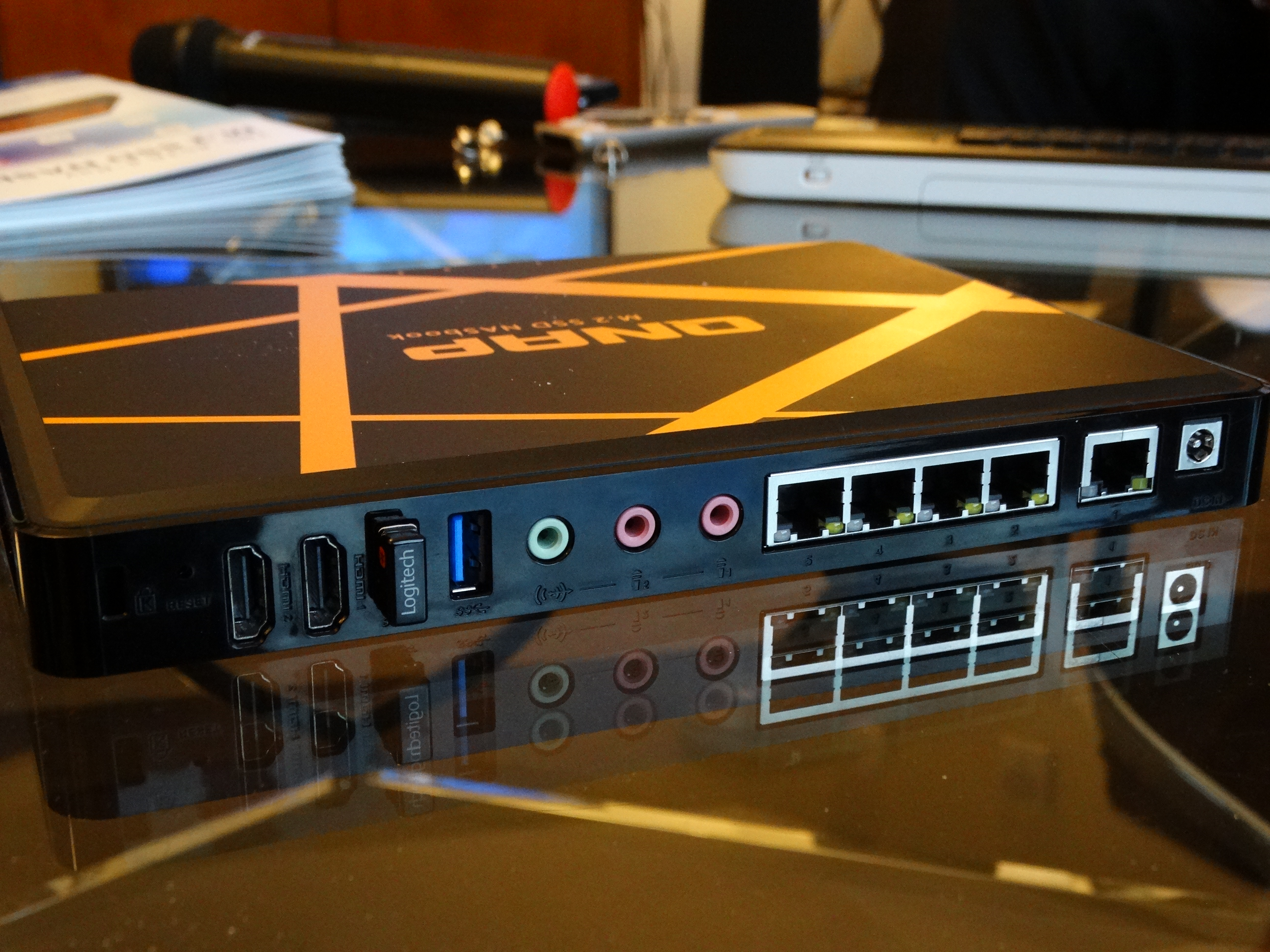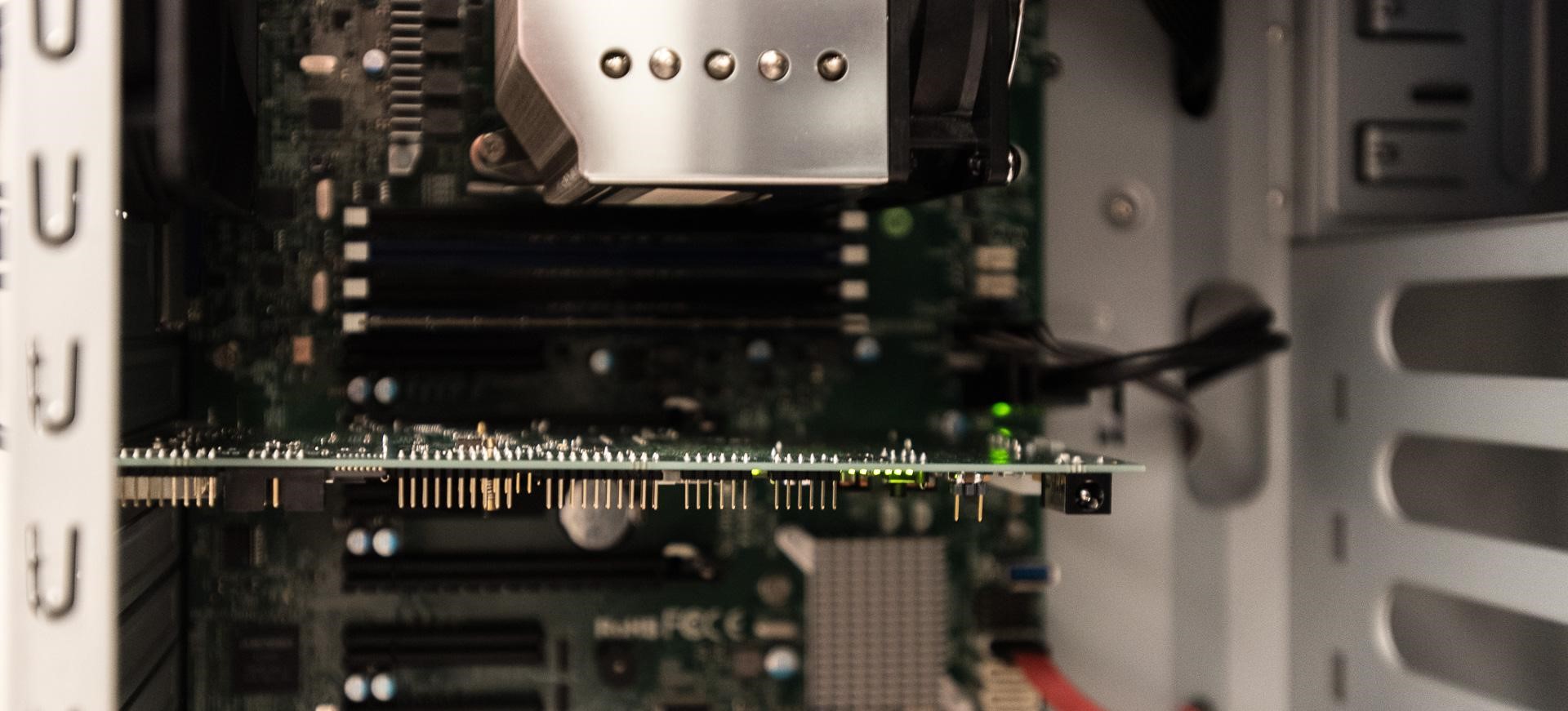Tom's Hardware's CES 2016 Top Picks
Best NAS
QNAP TBS-453A
For the last few months, several NAS manufacturers have entered the home router market, but only QNAP has combined a private network router with a NAS and home theater PC technology. The new trifecta device is the TBS-453A, and it's about the same size as a netbook.
The system has up to 8 GB of system DRAM, four SATA m.2 SSD slots, a local WAN and four LAN ports. Those combined features would be an excellent start to a network attached storage device that doubles as the network, but the TBS-453A goes a step further by adding dual HDMI outputs, four USB 3.0 ports, audio ports and a card reader.
The HDMI ports allow for local display support (home theater PC with KODI or other supported software) and real-time 4K H.264 video transcoding to other network attached devices. The system will remain responsive thanks to a highly optimized Intel Braswell SoC processor that consumes very little power.
Regardless of how you use the device, it's small enough to fit in any location, or you can opt to take it on the road as a traveling all-in-one device that can double as a PC.
MORE: All Storage News From CES
Best New Graphics Tech
PowerVR Wizard
From a company known for solid but not exactly flashy mobile graphics solutions, the PowerVR Wizard from Imagination looks to be something new. It's a PCI card, built with a specialized ray tracing processor. It's a low-powered, 10 watt card with passive cooling, but in a head-to-head demo, it rendered a scene five times faster than an Nvidia GeForce 980 Ti. Now, the test was undeniably set up in Imagination's favor, but we always love to see David take a shot at Goliath.
In addition to the head-to-head, we also got to see the four PowerVR Wizards running in tandem to render a flythrough of a scene. The rendering was done in Unity, which has worked with Imagination Technologies (maker of the PowerVR) to implement ray tracing in its APIs. The scene had more than 300 million light rays being rendered simultaneously, but the four little cards kept up an admirable 30 fps at 1080p.
Get Tom's Hardware's best news and in-depth reviews, straight to your inbox.
MORE: Imagination Demos Realtime Ray TracingMORE: All Graphics News From CES
Best System Concept
Razer Blade Stealth Ultrabook And Razer Core GPU Dock
You could argue that Razer swiped the idea of using a laptop paired with an external GPU dock from MSI and Alienware. You could further argue that Asus' new GPU dock is actually better than Razer's Core dock, because it uses PCIe x4 to pump full 40 Gbps over its USB-C connectors, whereas Thunderbolt 3 has an overhead penalty that drops its stated 40 Gbps to something lesser.
Those are strong arguments, but even so, we chose Razer's setup as our top pick. The docks from MSI, Alienware and Asus are all proprietary in some way and are thus married to a single device. It is true that so far, the Razer Core dock works just with the Razer Blade Stealth, and Razer reps wouldn't state definitively either way whether or not the Core would work with any device that had the correct USB-C port with Thunderbolt 3. But the Core (apparently) uses no secret sauce, so connecting other devices should theoretically work.
Further, there's the fact that Razer seems to have thought through an average gamer's ideal setup. You have the slim Ultrabook (with strong specs of its own), a powerful external GPU for when you need to rock and roll in demanding games, and a place to park all your peripherals. One cable connects that laptop to the whole schmeer, and charges it. (Asus' setup requires two cables.)
MORE: Razer's Blade Stealth Laptop And Core External GPU DockMORE: All Systems News From CES
Best Sign Of VR Promise
Jaunt VR
VR and 360-degree cameras made a rush at CES this year, but most of them, as impressive as they were, are consumer-grade products -- the GoPro of the VR camera world, as it were. Which is to say, they offer excellent-enough quality for you and me. But for the big boys, there's Jaunt. It's really not a product you can buy. It's a massive, professional-grade VR camera intended for movie making or broadcast recording (the company isn't going after live VR entertainment yet). The focus, if it isn't obvious, is quality. It has 24 HD camera modules, each with one-inch sensors with global shutters and HDR.
Most cameras employ rolling shutter sensors, which record moving objects from top to bottom. This scan-line effect can cause severe distortion when recording swift-moving objects. This is not ideal for immersive motion capture and makes it nearly impossible to stitch all of those images together perfectly. Global shutter records all scan lines at once. There's much more going on here, though, like the memory arrays behind the pixel cells (each pixel has a memory cell). The video gets uploaded to a cloud-based rendering system that combines all of the data and then reconstructs it as stereo output -- a virtual camera output for each eye. The company only does content partnership deals (which allows Jaunt to distribute the content on its own player in its app).
Okay, so shoot me: This is not really a product that's for you and me (although it's output is -- there's some really compelling content in the Jaunt app), but it's another sign that VR is serious business, and it's more than just gaming. Jaunt has raised $100m so far, just in case you're still not convinced.
Tom's Hardware is the leading destination for hardcore computer enthusiasts. We cover everything from processors to 3D printers, single-board computers, SSDs and high-end gaming rigs, empowering readers to make the most of the tech they love, keep up on the latest developments and buy the right gear. Our staff has more than 100 years of combined experience covering news, solving tech problems and reviewing components and systems.
-
clonazepam All of this VR talk has me on my hands and knees counting USB ports lol. Can't wait!Reply -
Onus Quick take. Mostly critical, but in many case more information would be very helpful. There is one absolute marketing fail in here though.Reply
ASRock's Mini-STX Motherboard And Mini-PC
Does indeed have "cool" written all over it.
OCZ Technology RevoDrive 400 1 TB
"Users will experience higher frame rates..."
Oh really?????????
Linksys WUSB6100M
I remain unconvinced of the adequacy of the antennas in these tiny dongles.
HTC Vive Pre
Ok.
Huawei Mate 8
Insufficient information. How long is the "outstanding" battery life? Is the battery user-replaceable?
In Win's H-Frame 2.0
In Win's H-Frame 2.0 chassis will retail for a heavy price of $799...
Stop right there; for people with more money than sense.
Kingston E1000 NVMe Enterprise SSD
Ok. More data needed.
Dell UltraSharp 30 Ultra HD 4K OLED Monitor
For $5K? Very niche, and perhaps for those who buy In Win's H-Frame 2.0.
Virtuix Omni VR Treadmill
Ok. If the price is reasonable...
CyberpowerPC's ProStreamer Series Gaming Desktops
Interesting concept, but ...Cyberpower? More information needed to determine quality and value, or lack thereof.
QNAP TBS-453A
Best NAS? Looks like its total capacity will be way too low. Gimmick.
PowerVR Wizard
Nice to see some new graphics tech. Ray-tracing is conceivably a great way to get realistic lighting.
Razer Blade Stealth Ultrabook And Razer Core GPU Dock
Insufficient information. It appears to have been selected in part based on suppositions.
Jaunt VR
Interesting. Might produce some great content.
-
RedJaron I'll back Joe on this. How can QCZ qualify their claim that a SSD will result in higher frame rates?Reply
I rather like that OLED monitor, though. Yeah, it's crazy expensive, but first adopter products tend to be. I hope this marks mfrs taking OLED seriously and trying to make them cheaper through a bigger production scale. -
Math Geek the razor ultrabook/gpu dock thingy is probably the most interesting thing i have seen from CES this year.Reply
the idea of the low power ultrabook for when i'm on the move that simply plugs into the base for with all my peripherals already ready to go for high power gaming sessions. don't know all the details as a lot is still unknown but overall i could see myself getting a lot of use from such a combo.
could replace the fact that i have a laptop and a desktop if done right. can't wait for more info on this product and the similar stuff i have seen on the horizon as well. -
turkey3_scratch Reply17285039 said:I'll back Joe on this. How can QCZ qualify their claim that a SSD will result in higher frame rates?
I rather like that OLED monitor, though. Yeah, it's crazy expensive, but first adopter products tend to be. I hope this marks mfrs taking OLED seriously and trying to make them cheaper through a bigger production scale.
I was under the impression that OLED displays were flexible, but I guess that changed? Is OLED basically just the LED replacement, or does it have anything related to flexibility? -
Crashman It was I who suggested the PCIe dock to MSI, around ten years ago. It just took them a while to catch up :)Reply
-
synphul Some oled can be flexible but that's not the main difference. The difference is an 'led' display is still an lcd display but with led's for backlights rather than fluorescent bulbs. Some led monitors are capable of lighting leds in groups/clusters rather than a full backpanel of constant light (which inevitably bleeds through causing grays rather than blacks). Led's are also smaller and more power efficient resulting in thinner displays than older lcd.Reply
Going back to oled, each pixel has its' own light source which is even more finely detailed lighting than led was compared to original lcd. Rather than having a constant area of backlight behind a 'black' pixel it can actually turn off.
Basically you get richer blacks, better contrast, more accurate picture from wide viewing angles, when pixels are lit the brightness is more uniform. It's due to the difference in panel tech. None of those features have to do with being flexible. -
FritzEiv Onus: Most of the things we covered in this piece we ALSO wrote about more extensively. Probably a "fail" is that we didn't link to some of those articles. I'll take that one on the chin (but also add that we all got very little sleep -- Seth & I averaged about 4 hours per night), and then we produced this on the very last night and got it ready today, making it our 101st story from CES (literally). So that's my excuse :-). Still, these are "impression" based and the point is to give a quick glimpse into what we saw and what stood out, not full-out specs. Sorry you felt let down.Reply -
alextheblue ReplyI'll back Joe on this. How can QCZ qualify their claim that a SSD will result in higher frame rates?
Higher frame rates*
*Enables streaming of a higher frame rate of raw uncompressed 4K video than would be possible with a slower solution.




